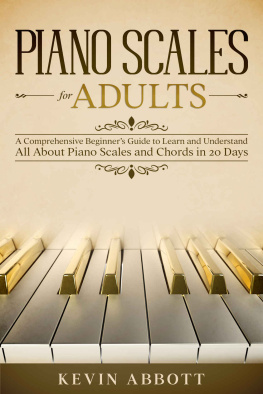Ken Richards - HOW TO PLAY PIANO: A GUIDE FOR BEGINNERS IN PLAYING PIANO, PIANO MUSIC, PIANO LESSONS, PIANO SCALES, AND PIANO THEORY
Here you can read online Ken Richards - HOW TO PLAY PIANO: A GUIDE FOR BEGINNERS IN PLAYING PIANO, PIANO MUSIC, PIANO LESSONS, PIANO SCALES, AND PIANO THEORY full text of the book (entire story) in english for free. Download pdf and epub, get meaning, cover and reviews about this ebook. genre: Home and family. Description of the work, (preface) as well as reviews are available. Best literature library LitArk.com created for fans of good reading and offers a wide selection of genres:
Romance novel
Science fiction
Adventure
Detective
Science
History
Home and family
Prose
Art
Politics
Computer
Non-fiction
Religion
Business
Children
Humor
Choose a favorite category and find really read worthwhile books. Enjoy immersion in the world of imagination, feel the emotions of the characters or learn something new for yourself, make an fascinating discovery.
- Book:HOW TO PLAY PIANO: A GUIDE FOR BEGINNERS IN PLAYING PIANO, PIANO MUSIC, PIANO LESSONS, PIANO SCALES, AND PIANO THEORY
- Author:
- Genre:
- Rating:5 / 5
- Favourites:Add to favourites
- Your mark:
HOW TO PLAY PIANO: A GUIDE FOR BEGINNERS IN PLAYING PIANO, PIANO MUSIC, PIANO LESSONS, PIANO SCALES, AND PIANO THEORY: summary, description and annotation
We offer to read an annotation, description, summary or preface (depends on what the author of the book "HOW TO PLAY PIANO: A GUIDE FOR BEGINNERS IN PLAYING PIANO, PIANO MUSIC, PIANO LESSONS, PIANO SCALES, AND PIANO THEORY" wrote himself). If you haven't found the necessary information about the book — write in the comments, we will try to find it.
If yes, then you got the right book. This book will serve as your guide towards your piano journey.
If you are thinking of a goal for how well you want to learn to play the piano, you can learn in several different ways. We will talk about many techniques for learning music and how to read sheet music. The basics of playing the piano are pretty much centered on how people know and you will see that can be used a lot in your life for other things.
One of the primary ways to learn the piano, without lessons, is to learn to play by ear. You would be surprised about how many people can do this! So how do you learn to play an instrument without a lesson? We will tell you! The first thing that you need for this is some keyboard. If you have one at home, it is much easier to practice than if you are using a friend. A piano is more comfortable to learn on if it does have 88 keys that work. You will also want to get the piano tuned so that the sounds of the keys are the correct ones, and you are not struggling with a piano that is out of tune.
Do you find yourself humming music a lot? Believe it or not, humming is one of the steps in learning to play the piano by ear! Sounds crazy, but if you master the art of humming, you should be able to master playing the piano by ear. Humming a song that you love actually can help you to internalize the song that you have in mind. Once you sit down at the piano, hum the song that you want to play. Keep humming it and then try to repeat it on the keyboard. You will then soon be able to play it note by note by merely mastering the art of humming your favorite songs. It may not be the similar as the person who has written it, but you are right and is making it on your own.
There are some things that you should know. We will talk about the keys on the piano and the sounds that some make. The white keys are called naturals, and the black keys are called accidentals. We will also talk about the notes on the piano, and it is essential to learn what those sound like before you can indeed start to master the art of piano playing.
This book covers:
- How to Play Piano By Ear
- Piano Music
- Piano Scales
- Advanced Playing Tips
- Finger Exercises
This instructional book will help you to learn where specific notes are on the piano. The book will be an excellent guide to help you learn how to balance the weight of your hands and play with both hands at once. This is not as easy as you may think, but I know that you can do it, and we are here ready to help you.
Click to buy now!
Ken Richards: author's other books
Who wrote HOW TO PLAY PIANO: A GUIDE FOR BEGINNERS IN PLAYING PIANO, PIANO MUSIC, PIANO LESSONS, PIANO SCALES, AND PIANO THEORY? Find out the surname, the name of the author of the book and a list of all author's works by series.













